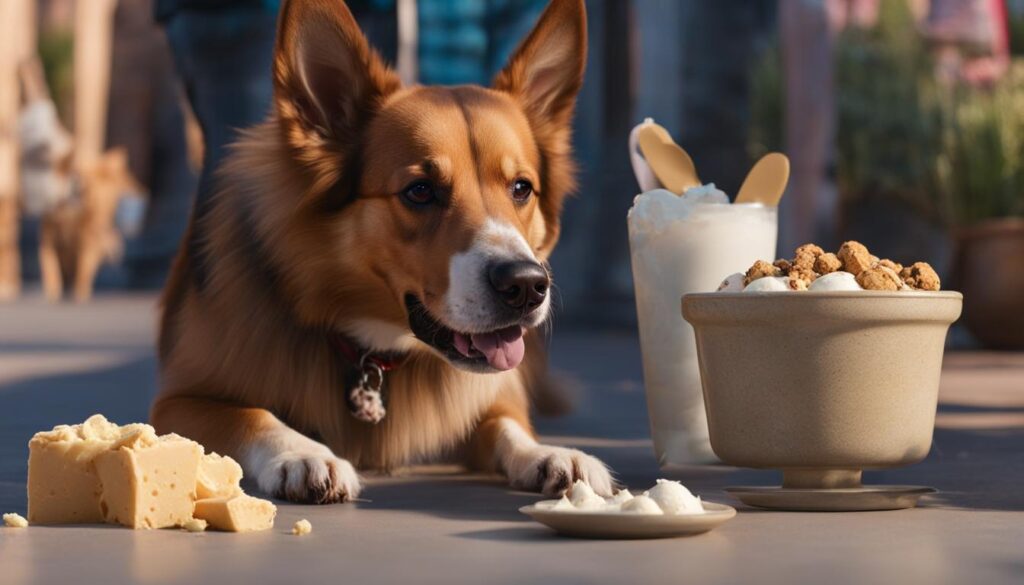As a dog owner, you may have wondered whether it’s safe to share your love for vanilla with your furry friend. Vanilla is a popular flavor and scent, and it’s not uncommon to find it in various food and beauty products. But can dogs have vanilla? Is it safe for them to consume?
The good news is that dogs can indeed have vanilla, but it’s important to use it in moderation and make sure it’s free from harmful additives. In fact, the scent of vanilla has been shown to have a positive effect on dogs, reducing their stress levels and promoting relaxation. However, there are a few things to keep in mind when giving vanilla to your dog.
Key Takeaways:
- Dogs can safely consume vanilla in small amounts.
- The scent of vanilla has a positive effect on dogs, reducing stress levels and promoting relaxation.
- Avoid giving dogs products that contain artificial sweeteners or excessive amounts of sugar.
- Vanilla extract is generally safe for dogs, but it’s best to consult with a veterinarian before introducing any new foods or treats into their diet.
- Homemade vanilla dog treats can be a healthy and enjoyable option, but make sure they are free from harmful additives.
The Power of Scents for Dogs

Dogs have a remarkable sense of smell, with up to 220 million scent receptors in their noses compared to humans’ five million. This incredible olfactory ability allows dogs to detect and distinguish a wide range of scents with unparalleled precision. Their powerful sniffers play a crucial role in various aspects of their lives, including communication, hunting, and navigating their environment.
It is fascinating to observe how scents can profoundly affect dogs’ behavior and emotional states. Research has shown that certain smells can have a calming and stress-reducing effect on our canine companions. One such scent is vanilla, which has been found to have a positive impact on dogs.
The comforting scent of vanilla can help dogs feel calmer and more relaxed. This makes it a useful tool in environments that may induce stress in dogs, such as shelters or during car rides.
Understanding Dogs’ Sense of Smell
To comprehend the significance of scents in dogs’ lives, it’s essential to grasp the extraordinary capabilities of their sense of smell. Dogs rely heavily on their noses to gather information about the world around them. Their sense of smell is estimated to be 10,000 to 100,000 times more powerful than that of humans.
Unlike humans, who primarily use their eyes and ears to perceive the world, dogs rely on their sense of smell as their primary sensory organ. They use their noses to navigate, locate food, identify social cues from other dogs, and even detect potential dangers such as predators or hidden substances.
The Impact of Scents on Dogs’ Behavior
Scents can have a profound impact on a dog’s behavior, emotions, and well-being. Certain smells can trigger physical and behavioral responses in dogs. For example, the smell of fear or distress in another dog may elicit a protective or cautious response from a dog. Conversely, the scent of a familiar and comforting aroma, like vanilla, can create a sense of calm and relaxation.
Studies have shown that exposure to pleasant scents, such as vanilla, can help reduce stress levels in dogs. This can be particularly beneficial in situations that may induce anxiety or fear in dogs, such as visits to the veterinarian, interactions with unfamiliar dogs, or during thunderstorms.
The Soothing Effects of Vanilla for Dogs
The comforting scent of vanilla has been found to promote relaxation and reduce stress in dogs. This natural aroma has a soothing effect on their senses, helping to create a calmer and more peaceful state of mind.
Vanilla has been used in various dog-related contexts to harness its stress-reducing benefits. It is often employed in environments like shelters to provide a more calming atmosphere for resident dogs. Additionally, during car rides, the scent of vanilla can help alleviate any anxiety or restlessness dogs may experience.
It is important to note that while vanilla can have a calming effect on dogs, it should not be considered a standalone solution for addressing behavior and anxiety issues. Proper training, socialization, and veterinary guidance should always be sought for comprehensive care.
The benefits of incorporating scents like vanilla into a dog’s environment extend beyond stress reduction. They can provide mental stimulation, promote relaxation, and contribute to an overall positive well-being. The use of scents should be combined with other strategies and interventions to support a dog’s emotional and behavioral needs effectively.
The Benefits of Vanilla for Dogs

Vanilla offers several potential benefits for dogs. It has a natural calming effect, helping to reduce anxiety and stress. Additionally, vanilla can aid in digestion, soothing upset stomachs and promoting a healthy digestive system. Vanilla also contains antioxidants, which have been linked to numerous health benefits in both humans and animals. However, it is important to note that these benefits are based on the moderate and controlled use of vanilla, and excessive consumption should be avoided.
Studies have shown that the scent of vanilla has a soothing effect on dogs, helping them relax and reduce stress levels. Whether it’s through the aroma of vanilla-scented toys or the use of vanilla-scented bedding, dogs can experience a calming effect that positively impacts their overall well-being.
The natural calming effect of vanilla can be particularly useful in situations that may cause stress for dogs, such as during thunderstorms or fireworks. By introducing vanilla-scented objects or incorporating vanilla into their environment, dog owners can help create a soothing atmosphere and provide their pets with a sense of comfort.
In addition to its calming properties, vanilla can also aid in digestion for dogs. It has been used as a natural remedy for upset stomachs and digestive issues. The soothing properties of vanilla can help alleviate discomfort and promote a healthy digestive system.
If your dog experiences occasional digestive problems, a small amount of vanilla extract can be added to their food to help soothe their stomach. However, it’s important to consult with your veterinarian before introducing any new ingredients or remedies into your dog’s diet.
Furthermore, vanilla contains antioxidants, which are beneficial for dogs’ overall health. Antioxidants help to protect cells from damage caused by free radicals and have been associated with a reduced risk of chronic diseases.
By incorporating vanilla into your dog’s diet in moderation, you can provide them with a natural source of antioxidants that may contribute to their long-term health and well-being.
Benefits of Vanilla for Dogs:
- Natural calming effect
- Aids in digestion
- Contains antioxidants
When using vanilla for dogs, it’s essential to remember that moderation is key. Excessive consumption of vanilla or any other ingredient can be harmful to your dog’s health. Always consult with your veterinarian before making any changes to your dog’s diet or introducing new ingredients.
The benefits of vanilla for dogs make it a valuable addition to their diet and environment. From reducing stress to aiding digestion and providing antioxidants, vanilla can contribute to your dog’s overall well-being when used responsibly.
| Benefits of Vanilla for Dogs | Description |
|---|---|
| Natural calming effect | Reduces anxiety and stress in dogs |
| Aids in digestion | Soothes upset stomachs and promotes a healthy digestive system |
| Contains antioxidants | Offers potential health benefits and protects against cell damage |
Vanilla Treats for Dogs
When it comes to treating our beloved furry friends, vanilla-flavored treats can be a delightful option. Whether you prefer to make homemade goodies or opt for commercially available options, there are plenty of suitable vanilla treats for dogs to enjoy.
Homemade Vanilla Dog Treats
If you enjoy getting creative in the kitchen, making homemade vanilla dog treats is a wonderful way to ensure your pup gets a tasty and wholesome treat. By using natural, dog-friendly ingredients, you can create treats that are not only delicious but also provide nutritional benefits.
To make homemade vanilla dog treats, try this simple recipe:
| Ingredients | Instructions |
|---|---|
|
|
By following this recipe, you can create homemade vanilla dog treats that are both delicious and safe for your pup to enjoy.
Commercially Available Vanilla Treats
If you prefer the convenience of pre-made treats, there are commercially available options that cater specifically to dogs’ love for vanilla-flavored goodies. These treats are often formulated with the right amount of vanilla to ensure they are both tasty and safe for consumption.
When choosing commercially available vanilla treats for your furry friend, it is important to read the labels and opt for products made with natural ingredients. Avoid treats that contain harmful additives or artificial sweeteners, as these can be detrimental to your dog’s health.
Now, let’s take a moment to appreciate our furry friends enjoying their delicious vanilla treats:
These adorable canines are savoring the scrumptious vanilla treats made with love and care.
Safety Precautions and Considerations

While vanilla is generally safe for dogs, it is important to be aware of certain precautions and considerations when using it. Dogs, like humans, can have allergies or sensitivities to certain substances, including vanilla. It is crucial to keep a close eye on your dog when introducing new foods or treats that contain vanilla. Watch out for any signs of allergic reactions, such as itching, redness, or gastrointestinal upset. If you notice any adverse symptoms, discontinue the use of vanilla and consult with a veterinarian.
Moderation is key when it comes to using vanilla with dogs. It is important to follow appropriate serving sizes and avoid excessive consumption. While the scent of vanilla can have a calming effect on dogs, using it excessively or in large amounts may lead to digestive discomfort or other health issues. It is always best to consult with a veterinarian before introducing any new ingredients into your dog’s diet.
Additionally, it is crucial to be cautious about the products you choose for your dog. Avoid giving your dog any products that contain artificial sweeteners or excessive amounts of sugar. These additives can be harmful to your dog’s health and may even cause toxic reactions. Always read the ingredient labels carefully and opt for natural, high-quality products that are safe for canine consumption.
| Precautions and Considerations | Description |
|---|---|
| Allergic Reactions | Dogs can have allergies or sensitivities to vanilla. Monitor your dog for any signs of allergic reactions, such as itching, redness, or gastrointestinal upset. |
| Moderation in Use | Follow appropriate serving sizes and avoid excessive consumption of vanilla. Too much vanilla can lead to digestive discomfort or other health issues. |
| Veterinary Consultation | Before introducing any new ingredients into your dog’s diet, consult with a veterinarian for professional advice and guidance. |
| Artificial Sweeteners and Sugar | Avoid giving your dog products that contain artificial sweeteners or excessive amounts of sugar, as these can be harmful to their health. |
Other Uses of Vanilla for Dogs

Vanilla can be a versatile addition to a dog’s life, offering benefits beyond just flavor. Here are some other ways vanilla can be used to enhance a dog’s well-being:
1. Homemade Treats with Vanilla Extract
Adding a small amount of vanilla extract as a flavoring in homemade dog treats or food can provide a touch of sweetness and delight for your furry friend. However, it’s essential to choose pure vanilla extract without any additives or artificial ingredients to ensure your dog’s safety and well-being.
Here’s a simple recipe for homemade vanilla dog treats:
Ingredients:
- 1 cup whole wheat flour
- 1/2 cup peanut butter (make sure it doesn’t contain xylitol, as it’s toxic to dogs)
- 1 teaspoon pure vanilla extract
Instructions:
- Preheat the oven to 350°F (175°C) and line a baking sheet with parchment paper.
- In a mixing bowl, combine the whole wheat flour, peanut butter, and vanilla extract. Mix well until a dough forms.
- Roll out the dough on a lightly floured surface to about 1/4-inch thickness.
- Use cookie cutters to create desired shapes and place them on the prepared baking sheet.
- Bake for approximately 15 minutes or until the treats are golden brown and firm.
- Allow the treats to cool completely before feeding them to your dog as an occasional tasty reward.
2. Occasional Treat: Vanilla Ice Cream
Some dog owners may consider giving their dogs a small amount of plain vanilla ice cream as an occasional indulgence. It can be a refreshing and enjoyable treat, especially during hot summer days. However, it’s vital to remember that moderation is key to prevent overindulgence and potential digestive upset in dogs.
3. Vanilla-Scented Toys and Bedding
The comforting scent of vanilla can provide familiar and soothing surroundings for your dog. Vanilla-scented toys and bedding can help reduce stress and promote relaxation. By incorporating these scented items into your dog’s environment, you can create a more peaceful and calming atmosphere for them.
4. Natural Vanilla Remedies
Vanilla has long been used in natural remedies for its potential benefits. While more research is needed in this area, some dog owners may explore natural vanilla remedies, such as vanilla-scented oils or sprays, to help alleviate anxiety or stress in their pets. It’s crucial to consult with a veterinarian for guidance on the safe use of these remedies for your specific dog.
| Uses of Vanilla for Dogs | Tips and Considerations |
|---|---|
| Homemade Treats with Vanilla Extract | – Choose pure vanilla extract without additives or artificial ingredients. – Ensure peanut butter does not contain xylitol, which is toxic to dogs. |
| Occasional Treat: Vanilla Ice Cream | – Offer plain vanilla ice cream in moderation as a refreshing treat. – Be mindful of potential digestive upset in some dogs. |
| Vanilla-Scented Toys and Bedding | – Introduce vanilla-scented toys and bedding to create a soothing environment. – Consider your dog’s preferences and monitor for any adverse reactions. |
| Natural Vanilla Remedies | – Consult with a veterinarian for guidance on using vanilla-scented oils or sprays. – Understand potential benefits and use them appropriately for your dog’s needs. |
Expert Advice on Using Vanilla for Dogs
When it comes to incorporating vanilla into your dog’s diet, it is essential to seek guidance from a trusted veterinarian. They can provide invaluable insights and recommendations tailored to your dog’s individual needs and health considerations. By consulting with a professional, you can ensure the responsible and appropriate use of vanilla for your furry companion.
Your veterinarian will be able to offer expert advice on a range of important factors, including appropriate serving sizes. Determining the right amount of vanilla to give to your dog is crucial to prevent overconsumption and potential adverse effects. Your vet can guide you on the ideal serving size based on your dog’s size, age, and overall health.
Additionally, monitoring for any adverse reactions or allergies is essential when introducing new foods or treats into your dog’s routine. While vanilla is generally safe for dogs, individual sensitivities can occur. Observing your dog closely for any signs of discomfort or adverse reactions, such as itching, digestive upset, or changes in behavior, is important. Your veterinarian can help you navigate these potential risks and ensure your dog’s well-being.
Remember that every dog is unique, and what may be safe for one dog may not be suitable for another. Seeking veterinary guidance on using vanilla for your specific dog’s needs is the best approach to ensure their safety and overall health.
Trust the expertise of your veterinarian to provide the best recommendations on using vanilla for your dog. Their guidance will help you make informed decisions, taking into account your dog’s individual considerations and ensuring a safe and enjoyable experience.
Exploring Other Dog-Friendly Scents

In addition to vanilla, there are other scents that can have positive effects on dogs’ behavior and well-being. Coconut, valerian, and ginger are among the scents that have been studied for their potential benefits in reducing stress and promoting relaxation in dogs. Each scent may have different effects, so it is important to explore and understand the specific benefits of each scent before use. It is worth noting that individual dogs may respond differently to various scents, so it may require some experimentation to find the scents that work best for a particular dog.
Coconut has a pleasant aroma that can help reduce anxiety in dogs. Whether in the form of coconut oil or coconut-scented products, this tropical scent has a calming effect on dogs, making it ideal for use in stressful situations or during grooming sessions.
Valerian is a natural herb known for its relaxing properties. When used as a scent, valerian can help soothe dogs and promote a sense of calm. It is often found in calming sprays, diffusers, or infused into bedding materials.
Ginger is another scent that can benefit dogs. It has anti-inflammatory properties and can aid in digestion, making it beneficial for dogs with gastrointestinal issues. Ginger-scented products or using fresh ginger in dog treats can provide a delightful aroma and potential health benefits.
It is important to introduce these scents gradually and observe how your dog responds. Some dogs may show positive reactions, while others may not have the same preferences. Understanding your dog’s individual preferences and sensitivities is crucial to creating a comfortable and stress-free environment.
Using Other Scents Responsibly
When using other scents for dogs, it is essential to prioritize their safety and well-being. Here are some key considerations:
- Choose products specifically designed for dogs, as human scents may be too strong or contain ingredients that are harmful to dogs.
- Use scents sparingly and in a well-ventilated area to prevent overwhelming your dog.
- Monitor your dog for any adverse reactions, such as sneezing, coughing, or signs of discomfort. If any negative reactions occur, discontinue use and consult with a veterinarian.
- Avoid using scents as a substitute for proper training or addressing underlying behavioral issues. While scents can be beneficial, it is essential to address any underlying causes of stress or anxiety in your dog.
By exploring different dog-friendly scents and observing your dog’s response, you can create a calming and enjoyable environment that enhances their overall well-being.
| Scent | Benefits |
|---|---|
| Coconut | Reduces anxiety and stress |
| Valerian | Promotes relaxation and calmness |
| Ginger | Anti-inflammatory properties and aids digestion |
A Balanced Approach to Treats and Scents

When it comes to treating our dogs and providing them with sensory stimulation, balance is key. It’s important to offer treats in moderation to prevent health issues such as obesity or gastrointestinal upset. Equally important is the use of scents as environmental enrichment to enhance a dog’s overall well-being and reduce stress. Scents, like vanilla, can have a calming effect on dogs, contributing to their mental stimulation and promoting relaxation.
However, it’s essential to remember that treats and scents should complement proper nutrition and care, rather than replace them. They are additional tools to enhance a dog’s quality of life and strengthen the bond between humans and their furry companions.
Moderation in Treating Dogs
When it comes to treating our dogs, moderation is key. While treats can be a great way to reward and reinforce positive behavior, excessive consumption can lead to health issues. Obesity is a common concern among dogs, which can lead to various health problems, including joint issues, diabetes, and heart disease.
By offering treats in moderation, dog owners can strike the right balance between reward and maintaining a healthy weight for their furry friends. Consulting with a veterinarian can help determine appropriate serving sizes and ensure that treats are incorporated into a balanced diet.
Using Scents as Environmental Enrichment
The power of scents should not be underestimated when it comes to improving a dog’s environment and overall well-being. Scents can have a positive impact on a dog’s mental and emotional state, reducing stress levels and promoting relaxation.
Vanilla, with its calming properties, can be used as a form of environmental enrichment for dogs. You can incorporate vanilla-scented toys or bedding into your dog’s environment to provide a comforting and familiar scent. This can create a soothing atmosphere, especially during times of change, such as moving to a new home or during thunderstorms.
Strengthening the Bond with a Dog
Treats and scents can also play a crucial role in strengthening the bond between humans and their canine companions. Using treats as rewards during training sessions can enhance the communication and trust between the dog and their owner. Positive reinforcement techniques, which often involve treats, can promote a cooperative relationship and mutual understanding.
Similarly, using scents, such as vanilla, can create positive associations and reinforce the bond with a dog. By introducing pleasant scents during activities like grooming or playtime, the dog can develop a sense of comfort and security, further deepening the bond between them and their owner.
Mental Stimulation for Dogs
In addition to physical exercise, dogs also require mental stimulation to prevent boredom and promote overall well-being. Treats can be used as a form of mental stimulation, such as through interactive toys or puzzle feeders, where dogs have to work to access their reward.
Scents can also provide mental stimulation for dogs. The sense of smell is highly developed in dogs, and introducing different scents can engage their cognitive abilities and provide a source of mental stimulation. Using scents, such as vanilla, in various activities can encourage exploration, problem-solving, and activity.
| Treats | Benefits |
|---|---|
| Homemade dog treats | – Allows for control over ingredients and ensures they’re free from harmful additives. – Provides an opportunity to cater to specific dietary needs or restrictions. – Can be a bonding activity with your dog during preparation. |
| Commercially available treats | – Convenient and readily available. – Offer a variety of flavors and textures. – Some brands are specially formulated with added nutrients for specific health benefits. |
The Role of Individual Preferences
Dogs, like humans, have individual preferences and tastes. Some dogs may love the scent of vanilla, while others may not respond as positively. Similarly, some dogs may enjoy certain treats, while others may have specific dietary restrictions or preferences. It is important for owners to observe and understand their dog’s preferences when using scents and treats.
A trial and error approach may be necessary to find the scents and treats that work best for each individual dog. By customizing the approach to dog care, owners can ensure that their furry friends receive the most enjoyable and beneficial experiences.
For example:
- Dog A may prefer a vanilla-scented toy and respond positively to vanilla-flavored treats.
- Dog B, on the other hand, may show more interest in treats with different flavors or scents, such as peanut butter or bacon.
- Dog C may have certain dietary restrictions or allergies that require the owner to explore alternative treat options or consult with a veterinarian for suitable alternatives.
Understanding and respecting individual dog preferences allows owners to strengthen the bond with their pets and provide tailored care. By paying attention to what makes their dog happy and excited, owners can create a more fulfilling and enjoyable environment for their furry companions.
The Importance of Observation and Adaptation
When introducing new scents or treats, owners should closely monitor their dog’s reaction. Some dogs may show immediate excitement and acceptance, while others may require time to adjust or may not respond positively at all. It is essential to be patient and open to adapting the approach based on the dog’s individual preferences.
“Every dog is unique, and what may be appealing to one dog may not be to another. It’s crucial to observe their response and make adjustments accordingly to ensure their overall happiness and well-being.”
Owners can keep a record of their dog’s preferences and reactions to different scents and treats. This record can serve as a valuable reference point when considering new options or making changes to their care routine. Additionally, consulting with a veterinarian can provide further insights and guidance based on the specific needs of the individual dog.
Benefits of a Customized Approach to Dog Care
A customized approach to dog care, including scents and treats, can offer several benefits:
- Enhanced enjoyment: By catering to a dog’s preferences, owners can provide experiences that are more enjoyable and engaging for their furry friends.
- Mental stimulation: Exploring different scents and treats can provide mental stimulation, keeping dogs mentally sharp and engaged.
- Improved overall well-being: A tailored approach to dog care can contribute to a dog’s overall well-being, promoting a positive and fulfilling lifestyle.
- Stronger bond: By understanding and meeting a dog’s individual needs and preferences, owners can strengthen the bond with their pets and create a deeper connection.
It is important to remember that a customized approach to dog care should be based on responsible and informed decision-making. Consulting with professionals, such as veterinarians or dog behaviorists, can provide valuable advice and insights to ensure the well-being and safety of the dog.
| Benefits of a Customized Approach | Examples |
|---|---|
| Enhanced enjoyment | Dog A shows excitement and happiness when offered vanilla-flavored treats. |
| Mental stimulation | Dog B engages in interactive treat puzzles that offer different scents and flavors. |
| Improved overall well-being | Dog C experiences reduced stress and anxiety when provided with lavender-scented bedding. |
| Stronger bond | Owner D and their dog engage in interactive training sessions using a variety of treats and scents, deepening their connection. |
Wrapping Up
In conclusion, dogs can safely enjoy vanilla in moderation, as it has been found to have a positive effect on their behavior and overall well-being. Whether in the form of treats or scents, vanilla can provide mental stimulation and promote relaxation in our furry friends.
However, it is crucial to consider individual dog preferences and consult with a veterinarian before introducing new foods or treats into their diet. The guidance provided by experts ensures that we make informed decisions tailored to our specific dogs’ needs.
Safety considerations should always be a top priority when it comes to our pets. Avoiding products that contain artificial sweeteners or excessive sugar is essential. By following expert advice and using vanilla responsibly, we can offer our dogs a safe and enjoyable experience.
Overall, with its benefits in promoting relaxation, aiding digestion, and its antioxidant properties, vanilla can be a valuable addition to our canine companions’ lives when used appropriately. By incorporating expert advice, considering safety considerations, and respecting our dogs’ individual preferences, we can provide them with the many benefits that vanilla has to offer.
FAQ
Can dogs have vanilla?
Yes, dogs can have vanilla in moderation. The scent of vanilla has a calming effect on dogs, reducing stress levels and promoting relaxation. However, it is important to avoid giving dogs products with artificial sweeteners or excessive sugar.
What are the benefits of vanilla for dogs?
Vanilla has a natural calming effect and can help reduce anxiety and stress in dogs. It also aids in digestion and contains antioxidants that promote overall health.
Can I give my dog homemade vanilla treats?
Yes, you can make homemade vanilla dog treats using natural ingredients like whole wheat flour, peanut butter, and a touch of vanilla extract. Just make sure to avoid harmful additives or artificial sweeteners.
Are there any safety precautions I should take when giving my dog vanilla?
While vanilla is generally safe for dogs, it’s important to monitor for any signs of allergies or sensitivity. Consult with a veterinarian before introducing new foods or treats and avoid excessive consumption.
Can I use vanilla extract or vanilla ice cream for my dog?
Vanilla extract is generally safe for dogs, but it’s best to consult with a veterinarian first. As for vanilla ice cream, it can be given as an occasional treat in moderation, but be mindful of potential digestive upset.
Can vanilla-scented toys or bedding benefit my dog?
Yes, vanilla-scented toys or bedding can provide a comforting and familiar scent for dogs, reducing stress and promoting relaxation.
Should I seek veterinary advice before using vanilla with my dog?
Yes, it’s always recommended to consult with a veterinarian before introducing new ingredients into your dog’s diet. They can provide guidance specific to your dog’s individual needs and health conditions.
Are there other scents that can benefit dogs?
Yes, scents like coconut, valerian, and ginger have also been studied for their potential benefits in reducing stress and promoting relaxation in dogs.
How should I approach treats and scents for my dog?
Treats should be given in moderation to avoid health issues. Scents can be used as environmental enrichment, but they should not replace proper nutrition and care.
Should I consider my dog’s preferences when using scents and treats?
Yes, dogs have individual preferences, and it may require some trial and error to find the scents and treats that work best for your dog. Pay attention to their response and adjust accordingly.






